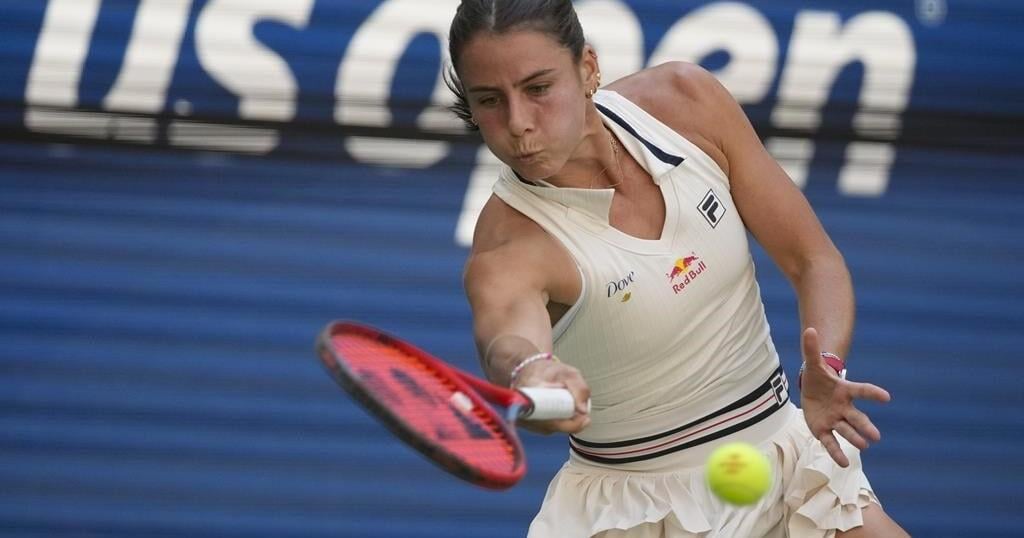NEW YORK (AP) — Emma Navarro rode a stunning turnaround right into her first Grand Slam semifinal, beating Paula Badosa 6-2, 7-5 at the U.S. Open on Tuesday to follow up her upset of defending champion Coco Gauff.
Taylor Fritz then earned his first berth in the final four of a major, beating 2020 U.S. Open runner-up Alexander Zverev 7-6 (2), 3-6, 6-4, 7-6 (3).
Fritz had been 0-4 in Grand Slam quarterfinals but finally broke through against Zverev, the No. 4 seed he also defeated in the fourth round at Wimbledon.
“I’ve had a lot of looks at quarterfinals over the last couple of years and today just felt different,” Fritz said. “I really felt like it was my time to take it a step further.”
Frances Tiafoe could give the U.S. a third semifinalist Tuesday — and a guaranteed chance to play for a championship — when he faced No. 9 Grigor Dimitrov at night. If he wins, the No. 20-seeded Tiafoe would play the 12th-seeded Fritz in Friday’s semis.
“That could be crazy, so I guess we’ll see what happens,” Fritz said, “but either way I’ll be ready to go.”
He controlled the action behind his strong serving, winning 20 of 21 points on his first serve in the fourth set and 81% in the match.
On the women’s side, Navarro was trailing 5-1 in the second set and was three points from having to go to a deciding third she she won the next four points to stay alive, starting a stretch in which she captured 24 of the final 28 points of the match.
“I think things weren’t looking great there in the second set, but just tried to be really tough, stick in there, make her hit one more ball,” Navarro said. “I felt like if I could scrap out a few longer points, maybe put some pressure on her, I felt like I could come back and maybe close it out in two sets.
“Happy with how I was able to do that.”
Navarro, the No. 13-seeded American who had never even won a match in the main draw of her home major before this year, advanced to face No. 2 Aryna Sabalenka or seventh-seeded Zheng Qinwen in Thursday’s semis.
The 23-year-old Navarro, who ousted the No. 3-seeded Gauff on Sunday in the fourth round, ran through the first set in 29 minutes before the No. 26-seeded Badosa opened a 5-1 lead in the second.
But when Navarro broke the Spaniard in the next game, the player who leads the WTA Tour with 18 wins in three sets had a feeling she might not need to play a third.
“I felt like, even though she was up 5-1, 5-2 after that game, I felt like she wasn’t totally confident in her ability to close out that set,” Navarro said. “So I felt like if I could push back a little bit and make her think a little bit on her service game, maybe I could sneak my way back in there.”
She did, taking six straight games with some help from Badosa, who said she was a “disaster” while dealing with the pressure of trying to reach her first Grand Slam semifinal.
“I never had the momentum in this match. I played four or five games OK. It was 5-1, but I never felt myself on the court,” Badosa said.
“I lost, I don’t know, 20 points almost in a row. It’s very weird for me because I’m quite a consistent player, so I wasn’t expecting that either.”
Navarro also beat Gauff in the fourth round at Wimbledon before losing to eventual runner-up Jasmine Paolini in the next round, a 6-2, 6-1 rout in less than an hour.
But the 2021 NCAA singles champion at Virginia was ready for this matchup between New York natives, jumping on Badosa to win the first three games, then seizing the opening Badosa gave her late.
Navarro became the sixth player in the last 40 years to reach the U.S. Open semis without a previous main-draw victory in the tournament, a list that includes recent champions Bianca Andreescu in 2019 and Emma Raducanu in 2021.
___
AP tennis:

























